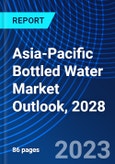This report comes with 10% free customization, enabling you to add data that meets your specific business needs.
1h Free Analyst TimeSpeak directly to the analyst to clarify any post sales queries you may have.
According to the research report Asia Pacific Bottle Water Market Outlook, 2028, the Asia Pacific Bottle Water market is expected to grow at a 7.81% CAGR by 2023-28. Rapid urbanisation and changing lifestyles in the Asia-Pacific region have led to increased demand for convenient and on-the-go hydration solutions. Bottled water provides a portable and easily accessible option for busy urban dwellers, making it a preferred choice for hydration. Growing disposable incomes across the Asia-Pacific region have fueled the demand for premium and branded bottled water products. Consumers are willing to pay a premium for higher-quality bottled water with perceived health benefits and superior packaging. Based on the product types, there are still water, functional water, sparkling water, and enhanced water. In the Asia-Pacific region, still water has the highest market share. Still water is often perceived as pure and unaltered, appealing to consumers who seek a natural and clean source of hydration. The absence of carbonation or additives enhances this perception of purity, making still water a preferred choice for many. In many Asian cultures, still water has a long-standing tradition and is deeply ingrained in daily life. Still water is often associated with tranquilly, balance, and health. This cultural preference contributes to the dominance of still water in the market. As well, still water is primarily associated with hydration, which is a crucial aspect of health and wellness. With the rising temperatures and humid climates in many parts of the Asia-Pacific region, consumers prioritise still water for its hydrating properties. In the future, functional water is expected to grow at the highest CAGR rate. There is a growing emphasis on health and wellness in the Asia-Pacific region, with consumers increasingly seeking products that offer functional benefits. Functional water, which contains added vitamins, minerals, antioxidants, electrolytes, or other beneficial ingredients, aligns with this trend. Consumers are looking for beverages that go beyond basic hydration and provide additional health benefits.
There are various government regulations and initiatives; many countries in the Asia-Pacific region have established regulatory standards for bottled water to ensure its safety and quality. These standards often cover aspects such as water sources, treatment processes, packaging materials, labelling requirements, and hygiene practises. The regulations aim to protect consumer health and maintain product integrity. Governments implement measures to ensure the safety and quality of bottled water. This includes regular monitoring, testing, and inspection of bottling facilities and water sources to ensure compliance with established standards. Regulatory bodies may also conduct audits and enforce penalties for non-compliance. Governments may implement policies and initiatives to manage water resources effectively. This includes measures to ensure sustainable water extraction, protection of water sources, and water conservation efforts. Such initiatives aim to maintain the long-term availability and quality of water resources used for bottling operations. Based on the distribution channel, which includes off-trade and on-trade, in the Asia-Pacific region, the off-trade segment is leading the market. Off-trade segments include hypermarkets, supermarkets, convenience stores, and others.
Based on the report, the Asia-Pacific market is segmented into five countries, including China, Japan, India, Australia, and South Korea. Among them, China will dominate the market in 2022. China has experienced rapid urbanisation and a shift in lifestyle patterns. As people move to urban areas and adopt busier lifestyles, there is a growing demand for convenient and on-the-go hydration options like bottled water. As well, China has faced challenges with water pollution and contamination issues in some regions. This has resulted in concerns about the safety and quality of tap water, leading many consumers to prefer bottled water as a safer and more reliable alternative. Furthermore, China attracts a significant number of domestic and international tourists. Bottled water is a popular choice among travellers who seek safe and reliable hydration options during their journeys.
There are several opportunities and trends for the bottle water market. The issue of plastic waste and environmental sustainability is gaining significant attention in the Asia-Pacific region. This creates opportunities for brands to introduce eco-friendly packaging solutions, promote recycling initiatives, and support initiatives for plastic waste reduction. Brands that demonstrate a commitment to sustainability can resonate with environmentally conscious consumers. There is a growing demand for functional and enhanced waters in the Asia-Pacific region. Consumers are seeking bottled water products that offer additional benefits, such as vitamins, minerals, electrolytes, or other functional ingredients. Brands can capitalise on this trend by introducing products that cater to specific health concerns or provide unique functional benefits. The Asia-Pacific region includes a diverse range of emerging markets with growing populations and rising disposable incomes. These markets present opportunities for bottled water brands to expand their footprint and capture new consumer segments. By understanding the specific needs and preferences of these markets, brands can tailor their offerings to effectively penetrate and succeed in these emerging markets.
Considered in this report
- Geography: Asia Pacific
- Historic year: 2017
- Base year: 2022
- Estimated year: 2023
- Forecast year: 2028
Aspects covered in this report
- Asia Pacific Bottled Water market with its value and forecast along with its segments
- Country-wise Bottled Water market analysis
- Various drivers and challenges
- On-going trends and developments
- Top profiled companies
- Strategic recommendation
Countries covered in the report:
- China
- Japan
- India
- Australia
- South Korea
By Products Type
- Still Water
- Sparkling Water
- Functional Water
- Enhanced Water
By Distribution Channel
- Off-Trade
- On-Trade








